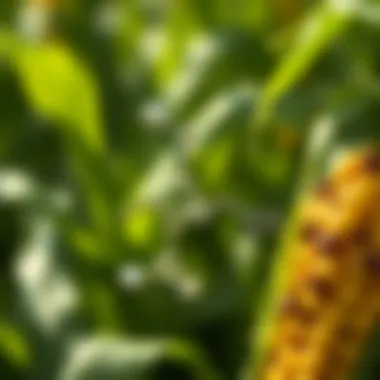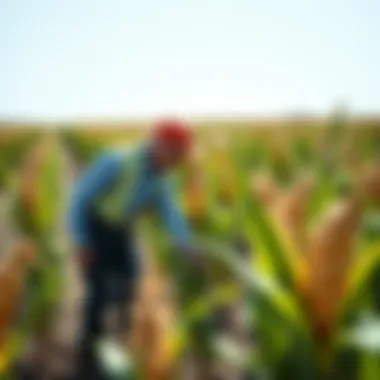Atrazine in Sweet Corn Cultivation: Insights and Impacts


Intro
Understanding the role of atrazine in sweet corn cultivation is pivotal for modern agricultural practices. Given its long-standing history as a herbicide, it has carved out a niche among farmers who seek efficient weed control solutions. A comprehensive analysis of atrazine encompasses its applications, effects on yield and quality, and the various environmental and regulatory aspects associated with its use. This article aims to equip agricultural professionals and enthusiasts with critical insights into atrazine, allowing them to make well-informed decisions regarding crop management and sustainable farming practices.
Key Concepts and Terminology
Definition of Terms
Atrazine is a selective herbicide commonly used in corn crops, designed to manage a variety of broadleaf and grassy weeds. It works primarily by inhibiting photosynthesis in plants, leading to their eventual death. Being a systemic herbicide, atrazine is absorbed by the roots and leaves, making it especially effective.
Overview of Relevant Practices
In sweet corn farming, the timing and method of atrazine application are crucial. The best practice involves applying atrazine as pre-emergence or early post-emergence treatment, ensuring that it acts effectively before weeds can establish themselves. This is often complemented with tillage practices to enhance the effectiveness of the herbicide. Moreover, factors like soil type, weather conditions, and crop stage play a critical role in the herbicide's performance.
Current Trends and Innovations
Latest Research and Developments
Research into atrazine is ongoing, with scientists investigating its long-term impact on soil health and aquatic ecosystems. Studies indicate that while atrazine has proven effective in weed control, there are discussions around its potential persistence in the environment, which raises questions about its safety for non-target organisms.
Emerging Technologies and Tools
Innovations in agricultural technology have also influenced atrazine application methods. Precision agriculture tools, such as GPS and drone monitoring, enable farmers to apply atrazine more accurately, reducing waste and mitigating any adverse effects on surrounding environments. These advancements are part of a broader trend toward sustainable agricultural practices that balance productivity with ecological responsibility.
Practical Applications
Step-by-Step Guides
- Preparation: Begin by assessing the field's weed population and selecting the appropriate atrazine formulation.
- Application Timing: Apply atrazine when sweet corn is at the appropriate growth stage—ideally when corn reaches 2-3 inches tall.
- Application Method: Use a sprayer equipped for herbicide applications to ensure even coverage across the field.
- Post-Application Monitoring: Regularly check fields for weed emergence and adjust additional treatments as needed.
Troubleshooting Common Issues
- Weed Resistance: If certain weeds continue to thrive, rotating herbicides with different modes of action can be effective.
- Environmental Concerns: Implement buffer zones near water bodies to minimize runoff and contamination risk.
Knowledge about atrazine is vital for maintaining robust sweet corn production while also addressing changing regulations and consumer preferences. This careful balancing act requires farmers to be well-versed in both the benefits and challenges posed by this herbicide, highlighting the importance of ongoing research and innovation in agricultural practices.
“Knowledge is a treasure, but practice is the key to it.” - Lao Tzu
For more detailed information about atrazine and its effects, visit these useful resources: Wikipedia on Atrazine, EPA Atrazine Information and agricultural forums such as Reddit Farming.
Intro to Atrazine
Atrazine sits at a pivotal intersection of agricultural practices and environmental stewardship. Understanding this herbicide is crucial for anyone engaged in sweet corn farming. The substance plays a significant role in managing weeds that threaten corn crops, providing a pathway to increased productivity. In this section, we will explore the historical backdrop that led to atrazine's widespread use and delve into its fundamental chemical characteristics that make it a viable option in contemporary agriculture.
Historical Context
Atrazine was first manufactured in the late 1950s and gained traction in the 60s and 70s as farmers increasingly needed effective solutions for weed management. Before its introduction, farmers had to rely on more manual weed control methods, which were labor-intensive and less efficient. The advent of atrazine transformed the landscape of weed management. By inhibiting photosynthesis in sensitive plants, atrazine provided farmers with an edge, allowing them to protect their crops during critical growth periods. Its effectiveness and versatility made it popular among corn growers and solidified its status in agricultural practices around the globe. However, as its usage became more prevalent, its environmental implications began to come under scrutiny. The balance between agricultural productivity and ecological health has since stirred considerable debate among farmers, regulators, and environmentalists alike.
Chemical Properties
Understanding atrazine's chemical properties is key to leveraging its benefits while managing potential drawbacks. Atrazine's molecular formula is C84ClN5, which indicates it is a chlorinated compound primarily categorized as a triazine herbicide. This structure contributes to its ability to disrupt photosynthesis in certain target weeds, effectively blocking the process that the plants need to thrive. Its high lipophilicity allows for excellent soil absorption, which helps ensure its sustained efficacy over time.
Moreover, atrazine exhibits a relatively low volatility, reducing the risk of it evaporating into the atmosphere. However, this same property raises concerns over its potential to leach into groundwater. In areas where atrazine is applied frequently, monitoring guidelines are critical to ensure minimal impact on non-targeted species and overall soil health.


By dissecting the chemical underpinnings of atrazine, growers can better appreciate its role and practice informed application strategies. Recognizing both its strengths and weaknesses allows for a more nuanced understanding, essential for navigating the delicate balance of effective weed control and environmental sustainability.
Role of Atrazine in Sweet Corn Cultivation
Atrazine serves as a pivotal factor in the cultivation of sweet corn, offering numerous benefits that are paramount to successful farming practices. Given the increasing competition from weeds and the relentless pressure on crop yield, understanding atrazine's role becomes indispensable for farmers keen on optimizing their harvest while managing environmental regulations. With its profound capacity for weed control, atrazine helps ensure that sweet corn plants can grow unhindered, leading to healthier crops and more substantial yields.
In the competitive realm of agriculture, every advantage counts and atrazine provides several specific benefits. Many farmers rely on this herbicide not only for its effectiveness but also because it is cost-efficient, which is crucial in an industry where every penny counts. Moreover, by using atrazine, farmers can adopt minimal tillage practices, which can enhance soil health while contributing to sustainability.
Weed Control Mechanisms
Atrazine's primary function resonates within its weed control mechanisms, which target a variety of problematic species often found in sweet corn fields. As a post-emergent herbicide, it operates by inhibiting photosynthesis in weeds, disrupting their ability to produce energy. This specific action results in the gradual die-off of unwanted plants, effectively reducing competition for nutrients, water, and light that sweet corn requires.
Farmers applying atrazine benefit from its broad-spectrum effectiveness; it combats annual grasses and certain broadleaf weeds. Some of the commonly targeted weeds include crabgrass and pigweed. This flexibility allows growers to manage mixed weed populations without the need for multiple different herbicides, simplifying their weed management strategies.
The application of atrazine is often timed to coincide with the early growth stages of weeds, ensuring that they are dealt with before they can set seed and further proliferate. This early intervention saves the crops from later infestations, emphasizing how crucial timing can be. In regions where sweet corn is prevalent, apt usage of atrazine is seen as a hallmark of modern agronomy.
Impact on Crop Yield
The usage of atrazine significantly correlates with improved crop yield, a vital consideration for any farmer aiming to maintain profitability. A clean field translates not just into lower weed competition but also into enhanced light penetration and better soil moisture retention. Sweet corn, being a high-value crop, thrives in these conditions.
Numerous studies have shown that proper atrazine application can lead to increased yields, even in conditions where weeds would have otherwise suppressed growth. In many cases, yields can increase by 20% or more, which represents a significant return on investment for strategical herbicide use.
Nevertheless, it is essential to note that the precise impact on yield can vary based on a myriad of factors, such as weather conditions, soil types, and management practices. Furthermore, farmers must remain vigilant about adhering to agronomic principles and ongoing research, as over-reliance on any herbicide can lead to resistance, which can nip future cropping prospects in the bud.
"Effective use of herbicides like atrazine is not simply about applying the product, but rather involves an integrated approach to weed management that includes crop rotation, soil health, and other essential practices."
Thus, atrazine remains a cornerstone of sweet corn cultivation, balancing weed control and maximizing yield potential while posing challenges that farmers must navigate carefully.
Application Methods of Atrazine
Understanding the application methods of atrazine is essential for effective weed management in sweet corn cultivation. It ties directly into how well the herbicide performs and, consequently, the yield and health of the crop. Farmers need to consider several elements, including the timing of application, precise dosage, and the techniques used to spread the herbicide evenly. Applying atrazine too early or too late, or in incorrect amounts, can lead to increased weed competition or damage to the crop. Therefore, having a firm grasp on these application methods is pivotal for optimizing results.
Timing of Application
Timing is everything, they say. In the context of atrazine, this couldn't be more accurate. The effectiveness of atrazine hinges significantly on the timing of its application. Generally, it is recommended to apply atrazine to sweet corn shortly after planting but before the weeds establish. This usually means treating the soil just before or right after planting when the conditions are optimal for herbicide activation.
A good rule of thumb is to apply the herbicide when soil temperature reaches around 50°F (10°C). This temperature ensures that atrazine can interact effectively with soil moisture, activating its properties to eliminate pesky weeds that compete for nutrients. Applying it too late increases the risk of weed emergence, while applying too early could lead to unwanted herbicide degradation before it can be effective.
Proper timing in the application of atrazine can offer substantial resistance against emerging weeds, ensuring that sweet corn plants have the best start possible.
Dosage Recommendations
To achieve the best results with atrazine, accuracy in dosage is vital. Over-application can negatively impact the sweet corn and the surrounding ecosystem, while under-application might not provide sufficient yield protection. The usual recommended dosage ranges from 0.5 to 2.0 pounds of active ingredient per acre, depending largely on specific regional conditions, soil type, and moisture levels.
Farmers should consult local agricultural extension services or specific guidelines from the herbicide manufacturers. These entities often have tailored recommendations considering factors like soil pH, matter content, and expected weed pressure. Using this information, practitioners can decide how much atrazine is just right for their circumstances, helping to maintain a delicate balance between achieving effective weed control and ensuring crop health.
Application Techniques
The technique used for applying atrazine can significantly affect the uniformity of its distribution and, thus, its efficacy. Common application methods include pre-emergence soil incorporation, broadcast spraying, and banding, each with its pros and cons.
- Broadcast Spraying: This involves evenly spraying atrazine across the field. It’s quick and covers large areas, but must be done carefully to avoid overlapping and excessive application.
- Soil Incorporation: This method involves mixing atrazine into the soil, typically by tillage, which can help improve its binding to soil particles and reduce off-target movement.
- Band Application: In this technique, the herbicide is applied only to rows where crops are planted, minimizing herbicide exposure to soil and non-target plants. This can be particularly advantageous in areas where sweet corn rows are narrow or during organic transitions.
Ultimately, the choice of technique should reflect the specific circumstances of the farm, including equipment availability, crop type, and farm layout. Properly mastering these methods can lead to a healthier sweet corn crop and a more efficient farming operation.
Environmental Considerations


Considering environmental factors is imperative when discussing atrazine, especially in the context of sweet corn farming. It not only affects agricultural practices but also touches on broader ecological concerns. Understanding these implications helps farmers and agronomists make informed decisions that could yield positive results both for their crops and for the environment. The significance of exploring the environmental aspects of atrazine arises from the need to strike a balance between effective weed control and maintaining ecological integrity.
Soil Health Implications
Soil is the heart and soul of agriculture, and atrazine's relationship with soil health is complex. On one hand, atrazine aids in the management of weeds, allowing crops like sweet corn to flourish without competition for nutrients. However, consistent atrazine usage can lead to various effects on soil composition and microbiome activity.
When applied correctly, atrazine can help preserve soil structure. It reduces soil erosion by suppressing weed growth, thus maintaining the soil's physical integrity. Yet, excessive or inappropriate application may lead to herbicide build-up. This can alter the pH levels and disrupt soil microbial communities responsible for nutrient cycling. Without these microorganisms, the soil may struggle to support healthy plant growth over time.
"Healthy soil is the bedrock of sustainable agriculture. Atrazine must be applied judiciously to promote both crop yield and soil vitality."
To sum up, understanding the impact of atrazine on soil health necessitates a careful evaluation of application practices. Strategies such as crop rotation and cover cropping can supplement herbicide use, allowing for a holistic approach to soil management that prioritizes long-term viability.
Water Quality Concerns
Another vital aspect to consider is the potential impact atrazine has on water quality. Being a water-soluble compound, atrazine can leach into groundwater and run off into surface water bodies, posing risks to aquatic ecosystems and drinking water. The concern over atrazine's presence in water supplies makes it a topic of discussion among policymakers and farmers alike.
There's a balance to strike here. Effective weed control through atrazine can enhance sweet corn yields; however, the potential consequences on water quality are hard to overlook. States like Michigan and Wisconsin have seen incidents where atrazine concentrations exceeded safe levels in drinking water, thereby raising health concerns. This underscores the need for vigilant application practices, including adhering to recommended dosage and timing criteria to minimize environmental risks.
In addressing water quality, farmers might employ practices like buffer zones, where vegetation is maintained alongside water bodies to absorb runoff and filter out contaminants. Furthermore, adopting Integrated Pest Management (IPM) strategies that consider the overall pest and weed ecology can reduce reliance on chemical herbicides like atrazine.
In essence, paying heed to water quality safeguards while harnessing atrazine’s efficacy is crucial for sustainability in sweet corn cultivation and the wider agricultural community.
Regulatory Aspects of Atrazine Use
The regulations surrounding atrazine, a widely utilized herbicide in sweet corn cultivation, play a pivotal role in shaping agricultural practices and safeguarding consumer health. Understanding these regulations is essential not just for compliance, but also for achieving sustainable farming that respects both ecological and economic balances. The nuances of atrazine regulation underscore the importance of informed management decisions.
Government Regulations
Atrazine's chemical properties and effectiveness against a wide variety of weeds have made it a common choice among farmers. However, with great power comes great responsibility—especially concerning environmental and health impacts. Enforcement of government regulations is aimed at ensuring safe use, preventing contamination, and preserving the integrity of soil and water resources.
In the United States, the Environmental Protection Agency (EPA) manages atrazine's approval and use. The regulatory framework includes:
- The Clean Water Act: Ensures that atrazine does not harm the quality of surface and groundwater.
- Label Regulations: Each product must have a label detailing how to apply the herbicide safely, including timing, dosage, and crop suitability.
- Restricted Use Classification: Some formulations of atrazine are designated for restricted use, meaning that only certified applicators can handle them to mitigate risks.
These measures collectively protect both the farmers and the environment and can influence farmers' decisions in their atrazine application strategies.
Compliance and Testing
To ensure adherence to regulations, compliance and testing protocols are crucial. Farmers and agricultural professionals must stay abreast of the latest federal and state laws regarding atrazine usage. Non-compliance can lead to severe consequences like fines, loss of crop yields, or even revocation of application licenses.
To achieve compliance, farmers should:
- Regularly review local and federal regulations to stay updated.
- Attend educational programs on safe herbicide application and risk management.
- Keep detailed records of atrazine application, including dates, amounts used, and environmental conditions on the application days.
Testing is equally important in this process. Water quality testing can help identify any contamination that may arise due to atrazine runoff. In many cases, state agencies monitor and report the presence of atrazine in water supplies. Farmers who risk exceeding regulated limits can face additional scrutiny or remedial actions to correct any environmental breaches.
"Regulations may seem burdensome, but they are designed to protect the farmer's future and the environment in which they work."
Alternatives to Atrazine
As the agricultural community increasingly scrutinizes the use of atrazine, exploring alternatives becomes pivotal. The importance of this topic is manifold; it not only addresses potential health and environmental concerns but also emphasizes sustainable farming practices. With the constant evolution of agricultural techniques, understanding alternative methods can enhance crop management and promote environmental stewardship.
Integrated Weed Management
Integrated Weed Management (IWM) presents a holistic approach to weed control that combines various strategies to reduce reliance on chemical herbicides like atrazine. IWM emphasizes the importance of cultural, mechanical, biological, and chemical methods, balancing them to create an effective weed management plan.


- Cultural Methods: These include crop rotation, cover cropping, and adjusting planting times. For sweet corn, rotating with different crops reduces the likelihood of specific weed species becoming dominant.
- Mechanical Methods: Techniques such as tilling, mowing, or using flame weeding help manage weeds without chemicals. These practices can disrupt weed life cycles while improving soil structure.
- Biological Control: This method utilizes natural predators or competitors to suppress weed populations. For example, certain insects or livestock may feed on weeds, reducing their prevalence.
Using IWM is not just about reducing atrazine’s application; it’s about creating a resilient cropping system that can better withstand environmental pressures. Farmers can significantly decrease their need for herbicides over time, leading to improved soil health and crop yield. Furthermore, incorporating IWM aligns better with consumer preferences for eco-friendly farming practices.
Organic Approaches
Organic farming methods offer another pathway to manage weeds without relying on synthetic herbicides like atrazine. These approaches may require more labor and management but can often lead to healthier ecosystems and sustainably produced crops.
- Mulching: Applying organic mulch such as straw or wood chips can suppress weed growth and retain soil moisture. This technique serves a dual purpose: it keeps weeds at bay while also enriching the soil as it decomposes.
- Cover Crops: Planting species like clover or vetch in the off-season can suppress weeds by outcompeting them for resources. When incorporated back into the soil, these cover crops can also enhance soil nutrient content.
- Hand Weeding: While labor-intensive, hand weeding can be effective, particularly in smaller fields or high-value crops. This method ensures that weeds are removed without disturbing the soil structure.
Implementing these organic methods might come with challenges like higher initial costs or labor demands, but the long-term benefits can be substantial. They contribute not only to soil health and biodiversity but also to creating a product that many consumers favor.
In summary, the discussion of alternatives to atrazine highlights the need for a shift towards more sustainable practices. Whether through integrated weed management or organic approaches, exploring these alternatives could lead to healthier crops and a healthier environment. Ultimately, the choice of strategy should align with the unique conditions of each farm and the broader goals of sustainable agriculture.
Future Trends in Herbicide Use
The agricultural landscape is always evolving, and the adoption of new technologies significantly impacts how crops are cultivated. Understanding the future trends in herbicide use is crucial for farmers and agricultural professionals. These trends not only affect the economics of crop production but also environmental health and sustainability practices. As we look ahead, several key areas demand attention, including advancements in research and development of herbicides, and the growing emphasis on sustainability initiatives.
Research and Development
Research in herbicide technology is undergoing transformative changes. Scientists are investing time and resources into developing new compounds that are both effective and environmentally sound. The prioritization of biologically-based herbicides is increasing. These alternatives are derived from natural sources, and they often present a lower risk to non-target organisms and ecosystems.
One notable area of research involves genetic engineering to create crops that are resistant to specific herbicides, while also tackling common weed species. This biotechnological advancement allows for targeted applications, minimizing off-target effects on the environment. Farmers can anticipate more precision agriculture techniques being rolled out, leveraging technologies such as drones and GPS for herbicide application. This not only enhances efficacy but can also reduce the amount of chemical required.
Ongoing trials and studies examine the use of microbial fermentation to produce bio-herbicides, representing an innovative approach to weed management. Such developments are promising as they align with consumer demands for reduced chemical inputs in agriculture.
"With the rapid advancements in herbicide technology and precision farming, the potential for sustainable agriculture is brighter than ever."
Sustainability Initiatives
Sustainability in herbicide application is more than just a buzzword; it reflects a shift in mindset across the agricultural sector. Farmers today are increasingly adopting practices that contribute to the broader goal of maintaining environmental integrity while ensuring productive farming.
One vital aspect involves the integration of cover crops and crop rotation practices. These strategies help suppress weed populations naturally while improving soil health and biodiversity. The use of cover crops can also minimize soil erosion and nutrient runoff, presenting a dual benefit to the ecosystem.
Moreover, many agricultural entities are focusing on developing integrated pest management (IPM) systems that include herbicides as just one tool in a larger toolbox. By utilizing a mix of cultural, biological, and mechanical weed control strategies, dependence on any single herbicide—like atrazine—can be reduced.
As a result of these initiatives, the future may see an increase in the certification of sustainable farming practices, offering consumers options that align with health and environmental standards. The demand for transparency in sourcing products will likely escalate, compelling farmers to adapt their practices accordingly.
In summary, the future of herbicide use in sweet corn cultivation is set to change dramatically, driven by innovations in research, a focus on biological solutions, and a commitment to sustainability. As these trends take shape, staying informed and adaptable will be crucial for every agricultural professional.
The End
The exploration of atrazine’s role in sweet corn cultivation wraps up with significant insights into its usage and implications. Understanding the layers of atrazine application is vital for farmers and agricultural professionals. The findings discussed throughout this article highlight the importance of informed decision-making when integrating atrazine into farming practices. In particular, comprehending the balance between weed control, crop yield, and environmental safety is crucial.
Summary of Findings
Over the course of this article, several key points regarding atrazine have been uncovered:
- Historical Context: Atrazine has a long history as a go-to herbicide in sweet corn, making it an established choice among farmers.
- Mechanism of Action: The chemical functions primarily by inhibiting photosynthesis in weeds, thus effectively controlling unwanted vegetation.
- Application Techniques: Understanding the timing and the right dosages are pivotal for maximizing effectiveness while minimizing risks.
- Environmental Considerations: The discussions around soil health and water quality reveal that atrazine's influence stretches beyond crops, impacting the ecosystem as a whole.
- Regulations and Compliance: Keeping abreast of governmental regulations ensures responsible use of atrazine, safeguarding both the farmers’ interests and environmental health.
- Alternatives and Trends: The emergence of integrated weed management and organic practices presents promising solutions for those looking to reduce dependence on synthetic herbicides.
These findings not only inform best practices but also foster a greater awareness of atrazine's implications in the agricultural landscape.
Recommendations for Practitioners
For those actively cultivating sweet corn, here are some actionable strategies:
- Stay Educated: Familiarize yourself with the latest research on atrazine, keeping up with advancements in herbicide development and environmental safety standards.
- Monitor Usage: Implement regular assessments of weed populations and atrazine performance on your fields to inform adjustments to your application strategy.
- Adopt Integrated Approaches: Combine atrazine with other weed control methods to enhance effectiveness and reduce reliance on any single product.
- Follow Regulations: Ensure strict compliance with local and national guidelines regarding herbicide application to minimize environmental impact.
- Participate in Workshops: Engage in workshops or community discussions that focus on sustainable practices and the future of herbicide use.
By taking these steps, practitioners can make meaningful contributions to a balanced agricultural ecosystem while ensuring the profitability of sweet corn farming.
Responsible management of atrazine not only benefits farmers but also leads to healthier environments for future generations.







